Close Family History & Genealogy
Close Last Name History & Origin
AddHistory
We don't have any information on the history of the Close name. Have information to share?
Name Origin
We don't have any information on the origins of the Close name. Have information to share?
Spellings & Pronunciations
Clausse, Claus
Nationality & Ethnicity
France & Switzerland
Famous People named Close
Are there famous people from the Close family? Share their story.
Early Closes
These are the earliest records we have of the Close family.

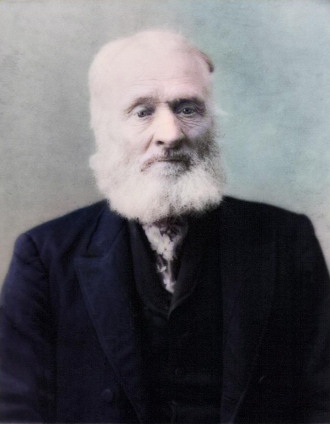

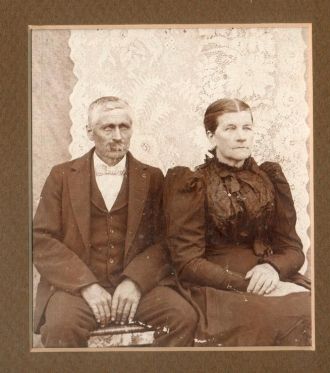
Close Family Members
Close Family Photos
Discover Close family photos shared by the community. These photos contain people and places related to the Close last name.

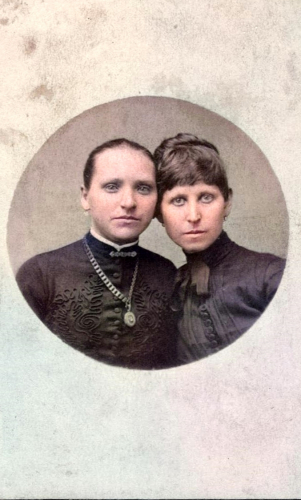


Christina or Christine MISNER was b. 1893 in Colorado to parents Andrew “Allen” Johannes MISNER (1839-1926) and Elizabeth HERREN or SCHULTZ (1851-1943). Christine was one of 6 children born to this couple including, Theresa; Barbara; Emma; Rosa or Rose M.; Bertha; and Christina or Christine “Tina” MISNER, all born between 1879 and 1893. Christina married Simon H. CLOSE on 23 Jun 1915 in Denver, CO and died in 1988 and is buried in the Evergreen Cemetery in Colorado Springs, CO.
Census records provide the following details:
1900 census of Franktown, CO:
Andrew MISNER, age 61, born Apr 1839, married 31 years, born Germany, parents born Germany, to USA 1859, a Farmer
Elizabeth MISNER, wife, age 48, born Jun 1851, married 31 years, 11 children/8 living, born Switzerland, parents born Switzerland, to USA 1851
Theresa MISNER, dau, age 20, born Jun 1879, born CO
Barbara MISNER, dau, age 18, born Feb 1882, born CO
Emma MISNER, dau, age 16, born Feb 1884, born CO
Rosa MISNER, dau, age 13, born Mar 1887, born CO
Bertie MISNER, dau, age 9, born Sept 1890, born CO
Christina MISNER, dau, age 7, born May 1893, born CO
Michael MISNER, brother, age 67, born Feb 1833, born Germany, parents born Germany, to USA 1860, a Farm Laborer
1910 census of West Castle Rock, CO:
Andrew MISNER, age 71, married 41 years, born Germany, parents born Germany, to USA 1859, Own Income
Elizabeth H. MISNER, wife, age 59, married 41 years, 11 children/8 living, born Switzerland, parents born Switzerland, to USA 1852
Barbara MISNER, dau, age 28, born CO
Rosa MISNER, dau, age 23, born CO, a Dressmaker
Bertha MISNER, dau, age 20, born CO, a Private Home Servant
Christine MISNER, dau, age 17, born CO
Michael MISNER, brother, age 77, born Germany, parents born Germany, to USA 1867
1920 census of Colorado Springs, CO:
Simon H. CLOSE, age 28, born IN, parents born IN/PA, a Police Dept Secretary
Christena CLOSE, wife, age 26, born CO, parents born Germany/Switzerland
Cora E. CLOSE, dau, age 1 year + 6 months, born CO
1930 census of Colorado Springs, CO:
Simon H. CLOSE, age 39, married at age 24, born IN, parents born IN, a Police Dept Secretary
Christine CLOSE, wife, age 36, married at age 22, born CO, parents born Germany/Switzerland
Cora E. CLOSE, dau, age 12, born OK
1940 census of Colorado Springs, CO:
Simon H. CLOSE, age 49, born IN, a Police Dept Secretary
Christine CLOSE, wife, age 46, born CO
Cora CLOSE, dau, age 21, born OK, a Theatre Cashier
I am hoping to locate someone from this family so that this beautiful old photograph can be returned to the care of family. If you are a member of this family, or you know someone who might be, please contact me.
Thanks,
Shelley
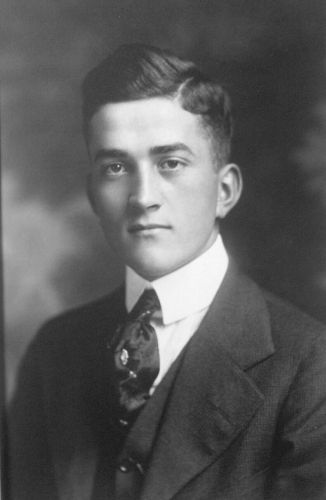


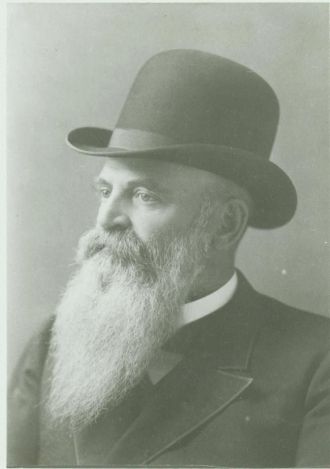
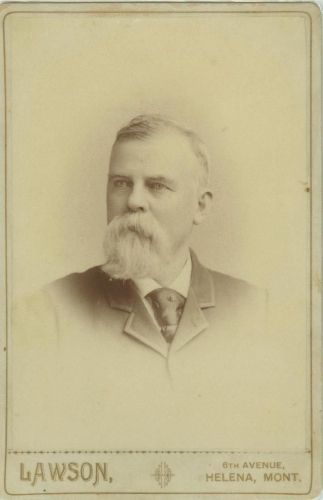
Close Family Tree
Discover the most common names, oldest records and life expectancy of people with the last name Close.
Updated Close Biographies
Popular Close Biographies



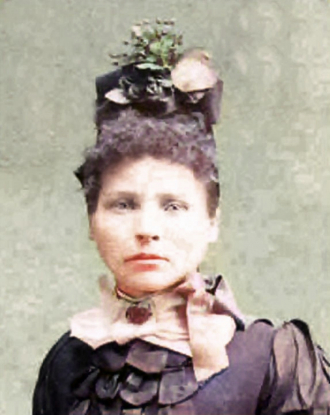

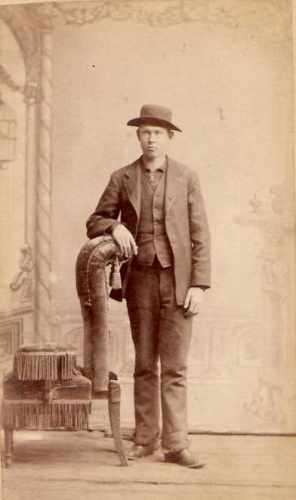





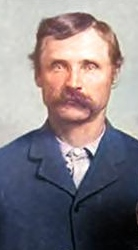




Close Death Records & Life Expectancy
The average age of a Close family member is 74.0 years old according to our database of 3,734 people with the last name Close that have a birth and death date listed.
Life Expectancy
Oldest Closes
These are the longest-lived members of the Close family on AncientFaces.
Other Close Records
Share memories about your Close family
Leave comments and ask questions related to the Close family.
MONTANA PIONEER
Abraham Stearns Blake was born in New Haven, Addison County, Vermont, November 29, 1837 of Puritan ancestors. He was the sixth in a family of seven children. His mother Marie died when he was four, and the younger children were raised by a step-mother. His father Abijah was a sea-captain who would be gone from home “sometimes for a year at a time.”
In 1855, at age seventeen, Stearns left his home in the East and sailed, via Nicaragua, to California. He found the city of San Francisco “fascinating to a farm boy from the hills of Vermont.” He was soon anxious, however, to leave the fascinations of the city for the excitement of the gold fields. He joined a group of young men who were headed for Yuba City and he stayed in that area for the next six years.
In 1861 Stearns journeyed to Portland, Oregon to join his brother Levi Lowell Blake. Levi, who was more than seven years older than Stearns, had been living near Fort Owen in the Bitter Root Valley of Montana (Washington Territory), and together they returned to that area, prospecting in Idaho along the way.
Upon his arrival in the valley, Stearns met Perry W. McAdow and Major William Graham. With gold foremost on their minds they soon left the Fort for the gold fields at American Fork in the Deer Lodge Valley. They were among the first prospectors at Gold Creek and Stearns is credited with being “the first man in Montana to find gold in paying quantities.” He counted this summer at the American Fork as “one of the happiest of my life
While at Gold Creek Stearns became associated with Granville and James Stuart, and soon these men, including S. T. Hauser (Territorial Governor, 1885-87) moved from Gold Creek to Bannack City. This was late in the year 1862 when Bannack City consisted of a store and three log cabins.
Together these men planned the “1863 Stuart Expedition to the Yellowstone Country.” James Stuart was elected Captain of the venture, and the purpose was to “prospect for gold and secure townsites in the Yellowstone Basin.
Fifteen men were on the ill-fated Yellowstone Expedition; seven were wounded
in a battle with the Crow Indians (two of the wounded died by their own hand to keep from holding up the rest of the party) and the survivors felt more than lucky to be alive when they finally returned to civilization, such as it was. They had traveled “sixteen hundred miles through the Crow Nation, and for the last twelve hundred, without tents or even a change of clothes.”
After this harrowing adventure Stearns returned to Bannack for a short time, but soon he joined Levi, who “had some valuable claims” near Idaho City. They stayed in that area for four years.
Both of the brothers returned to the Bitterroot Valley and Fort Owen many times, but in 1867 “tired of a miners life,” Stearns returned to Fort Owen to live. For the next two years he farmed the land around the fort with his friend and companion, Major John Owen.
John Owen recorded in his diary “I have a Jewel in young Blake.” “He is a Jewel, always doing Something.”
At Fort Owen Stearns met and married Mary Use. Mary was an Indian orphan from the Shoshone Indian tribe, who had come to live with John Owen and his Shoshone wife, Nancy. Mary Use helped to care for Nancy who was ill, and was her friend and helpmate until Nancy’s death in 1868.
With the Homestead Act of 1869 Stearns and Mary acquired 320 acres at Victor, Montana, where they farmed 100 acres and raised hogs and cattle. There they built one of the most elegant homes in the Bitterroot Valley.
During the battle of the Big Hole in 1877, Stearns fought as a civilian against the Nez Perce. This battle lasted only a few weeks as the Indians continued on their trek toward their destination, the Canadian Border. There the Nez Perce surrendered to federal troops. This act, with the familiar statement of Chief Joseph, -- “I will fight no more, forever” – virtually ended Indian resistance in Montana.
Stearns was one of the discoverers of the Curlew Mine at the mouth of Big Creek, not far from his home. Some three million dollars of Galena (lead & silver) ore was taken from the Curlew during the 1880’s and 1890’s, making it one of the most significant and prosperous mines in the valley.
ABRAHAM STEARNS BLAKE was truly one of the earliest pioneers of Montana, coming at a time when scarcely a thousand white men lived in the entire territory. He was made a Master Mason in 1858 and was a Republican from the formation of the party. He played an important part in the history of Montana; being elected a Member of the House of Representatives at its first session, 1889-90, and a Delegate of the State Legislative Assembly in its second session, 1891-92.
Mary Use Blake and Abraham Stearns Blake lived out their lives in their beautiful home at Victor. They had eleven children. One of the first six, Joseph, lived to age seventeen, while five others; Richard, George, Emma, Frank and Nellie, died in their childhood. Five more children followed; Julia Blake Yates, John A. Blake, Anna Blake Reed, Edward Blake and Bertha Blake Rowan. All were well-loved, life-long residents of the community of Victor, Montana.
By, Pat Close
OF VERMONT
Abijah Blake was the son of Levi and Polly (Kelly) Blake. He was born in Swanzey, New Hampshire in 1801. Abijah moved to Rutland, Vermont soon after his marriage to Maria (Belding) Blake in 1826. They both died in Vermont and are buried at the Elmwood Cemetery in Northfield.
Abijah learned the trade of tanner from his father, but later he became a sea captain. He sailed around the Cape to California, picking up loads of wheat, and would often take the cargo to Europe before returning home to Vermont. Sometimes he would be gone from home for a year at a time.
Maria Belding was born in Swanzey, NH also. She was the daughter of Elijah and Margaret Belding. Elijah was known as “The Squire” or Honorable Belding. He officiated at the marriage of Abijah and Maria, who were married on the steps of the old Belding homestead in Swanzey.
Abijah and Maria moved to New Haven, VT before their first child was born in 1828. They had seven children, all born in New Haven, Addison County, VT.
Eliza Augusta was born Feb.23, 1828. She married D. C. Bradley and
lived in Chicago. She died there in 1856, at the young age of twenty-eight.
Levi Lowell was born April 21,1830. He was an early pioneer of Montana, but later moved to Wash. D. C. where he died in 1904. He is buried in Northfield, VT.
Ellen Marie was born April 1,1832. She married the Honorable George Nichols, who was a very fine physician. Ellen died in 1905 at Northfield, VT.
Mary Louise was born Feb.5, 1834. She married John Elliot Smith. They lived in Portland, ME. She died there in 1913.
Elijah Belding Blake was born May 9, 1836. Elijah married Mary Ruth (?), they had one daughter, Ida Blake, and lived in Worcester, MA where Elijah died in 1916.
Abraham Stearns Blake was born Nov. 29, 1837. He made a name for himself as one of the earliest pioneers of Montana, and died in Victor, MT in 1907.
William Carr Trowbridge Blake was born Sept.15, 1839. In his twenty’s William followed his older brothers to Montana. He was employed as a horticulturist for a greenhouse in Deer Lodge, MT. He contracted typhoid fever and died there in 1872 at the young age of thirty-three.
The mother Marie Blake, died in 1841, two years after William Carr was born. Abijah then moved to Vergennes, VT, where he re-married. He and his new wife, Parthana had one child, George Blake, who was born in 1847.
The Blake family was made up of remarkable people. Levi Lowell Blake and Abraham Stearns Blake were early gold miners in California and in Montana. They became noted men in Montana History.
Levi Lowell served in the Mexican American War. He then made a small fortune in the California gold fields. He was in Montana with the Gov. Stevens Railroad Survey and worked closely with John Mullen who pioneered the first wagon road from Fort Benton to Walla Walla, Washington. In an election held July 14, 1862, Levi was elected representative to the Wash. Territorial Legislature. However, “on his way to the legislative session in Olympia, he was side tracked by the gold fields near present day Boise, ID, and never assumed the office.” He earned the title of Major Blake in 1867 for his services to the government, acting as Indian Agent on the Jocko Reservation near Polson, MT. He was officially elected to the post in 1869 but did not accept it. He returned to the east to live.
In 1870 Levi located in Wash. D. C. where he became part owner in the Marshall Hall Steamship Company. He traded the title of Major Blake for that of Captain Blake. He was the Captain of several pleasure steamers that plied the Potomac River to Mt. Vernon and the Marshall Hall Amusement Park. He was variously listed as captain of the “Mary Washington,” the “W.W. Corcoran,” the “Charles Macalaster,” and the “Steamer Arrow.” The Marshall Hall Steamship Co. later acquired the famed “River Queen,” of 1864. The “River Queen” had frequently been referred to as “Lincoln’s Favorite,” a/c his frequent use in the closing days of the Civil War.
At the age fifty-six, Levi married Marie (Robinson). They had a daughter, Marion, and a son Lowell Blake.
Levi died in Wash. D. C. in 1904 and, “with the consent of his wife, his burial expenses were assumed by the Mount Vernon Ladies Association as a gesture of appreciation and thanks for his many services.” His body was shipped, via Penn. R.R. to Northfield, VT, where he is buried with other members of his family.
At age seventeen, Abraham Stearns Blake left Vermont and sailed, via Nicaragua to California. He mined in the gold fields there for six years and then journeyed to Montana, where he mined at Gold Creek in the Deer Lodge Valley, and was one of the first white men to find gold in paying quantities. He was on the ill-fated “1863 Stuart Expedition to the Yellowstone Country,” and is written up for that story, and many others, in many Montana History Books.
At Fort Owen in the Bitterroot Valley, Abraham Stearns met Mary Use, a Shoshone Indian girl, (daughter of a Chief). They were married in 1869 and homesteaded in Victor, MT.
Abraham Stearns Blake played an important part in Montana history. He was elected a Member of the House of Representatives at its first session, 1889-90, and a Delegate of the State Legislative Assembly in its second session, 1891-92. He and Mary lived out their lives in Victor. Stearns died in 1907 and is buried at the Victor Cemetery beside his wife and the first six of their eleven children.
By: Pat Close [contact link]
MISSOULA, MONTANA
Our Grandmother and Grandfather, Katarina Weiss and Fredrick Sayler im-migrated to America just a few months apart, in 1905. Their families had lived not far from each other in Russia but they did not know each other. When they arrived in America they both went to work on farms in North Dakota, and that is where they met.
Katarina’s Father, John Frederick Weiss was a carpenter and a Lay Minister. Her Mother, Margaretha Derheim Weiss was a mid-wife who traveled some times for days at a time, doctoring her fellow neighbors.
The Weiss family consisted of twelve children, six sons and six daughters. Only four lived to an old age. All were born in Neudorf, Bergdorf or Odessa, South Russia.
Fredrick’s parents were Gottlieb Sayler and Katherina Schmidt Sayler.
The Sayler family, like the Weiss family, was of German descent. Their families migrated to Russia when Catherine II invited the Germans to settle there with “special rights and privileges.” “All the families would receive a certain amount of land to build houses and the men and boys would not have to serve in the Army or go to War.”
These German Colonists settled mostly along the west side of the Volga River. And our ancestors settled in colonies just above the Black Sea. -- Within a quarter of a century these German Immigrants made South Russia the “Bread Basket of the Czars.”
In 1876, under different rulers, the Russian Government took away all the German-Russian Peoples’ rights and privileges. They had a choice of migrating to Siberia, where they could buy land and farm as they had before, or immigrate to North and South America.
Luckily for us, Grandma and Grandpa came to North America. They settled in North Dakota, and were married in Hebron on Feb. 22, 1906. They lived in Hebron, Glen Ullin, and Elgin before moving to Missoula, Montana, about 1924. They had seven children and lived out the remainder of their lives in Missoula.
Fredrick passed away in 1937. Katherine lived another twenty-six years. She passed away in 1963. Both are buried in the Missoula County Cemetery.
By: Pat Close
William Carr Blake was born in Northfield, Vermont, September 15, 1839. He followed his older brother’s, Levi Lowell Blake and Abraham Stearns Blake to Montana about 1866. Both Levi and Abraham Stearns were well-known Montana Pioneers.
Levi Lowell Blake came to Montana with the Governor Stevens R. R. Survey. By 1860 he was living at Fort Owen in Stevensville and taking supplies to John Mullan, who was building the Mullan Road from Fort Benton to Walla Walla, Washington. In 1870 Levi returned to the East to live, and became the Captain of several different Steamships which plied the Potomac River from Washington D. C. to MT. Vernon.
Abraham Stearns Blake came to Montana from the California gold fields in 1861. He remained in Montana until his death at his home in Victor, MT in 1907. He was a member of the House of Representatives at its first session, 1889-90 and a Delegate of the State Legislative Assembly in its second session, 1891-92.
William Carr Blake located in Deer Lodge in 1867 and was employed as a horticulturist at a local greenhouse. In 1872 a quote from the local newspaper credits him with being the most superior horticulturist in the territory.
NEW NORTHWEST DEER LODGE 1872
*********LOCAL NEWS**********
THE GREEN HOUSE – For some weeks past Mr. Blake has been putting in order Olin’s Green House, adjoining town, which attracted so much attention last year. He has already sown a great many seeds, and will have radishes, lettuce, etc., in the market in a few days. Everything grows as if by magic, the beds being heated by hot water pipes underneath them, and the steam furnishing moisture. Mr. Blake has no superior in the Territory as a Horticulturist, and is also a fine Botanist and converses fluently with the flowers in their different tongues, even though many of them speak by aid of the “dead languages.” He will have a great variety of flowers, from the largest gardens of the East; and tomatoes, --etc. etc…. for transplanting when the proper time arrives. Persons having house plants that were cut down by the cold, can leave them in the green-house and in a short time they will revive again. A number of such are there now, doing finely.
Another 1872 entry reads as follows:
NEW NORTHWEST DEER LODGE, MONT.
Recovering – Warden Gilchrist was removed to his room at the Prison several days ago, and is getting along finely. He will soon be around all right again.
Mr. W. C. Blake, who was stricken down with typhoid fever some ten days ago, is at the Scott House, improving rapidly. Disease attacked both these gentlemen with unusual severity, but through the skillful treatment and careful attention of their physician (Dr. Whitford) their friends will be rejoiced to know they will soon be as well as ever.
After seemingly having recovered from Typhoid Fever, William was again taken ill, and died May 10, 1872.
Following is his MEMORIAL RESOLUTION:
Died--
Blake – In Deer Lodge. Friday May 10, of Typhoid Fever. Wm. C. Blake, a native of Northfield, Vermont, aged 33 years.
MEMORIAL RESOLUTIONS
At a meeting of the citizens of Deer Lodge City, Montana, at the Court House. On the 13th day of May, 1872. For the purpose of paying proper respect to the memory of the late William C. Blake, deceased. Col. W.L. Irvine was called to the Chair, who stated the object of the meeting, and J. C. Robinson was chosen Secretary.
On motion, the Chair appointed Rev. W. H. Stoy, E. S. Stackpole and W. A. Clarke a Committee to draft Resolutions; who reported the following preamble and resolutions., which were unanimously adopted.
Inasmuch as it hath pleased Almighty God, in His wise Providence to remove from our midst the soul of our deceased friend and fellow citizen William C. Blake; Therefore be it.
Resolved. By us. The citizens of Deer Lodge City, of the Territory of Montana; That, while we bow in humble submission to the Divine Will, we do recognize in this afflictive dispensation the loss of a most worthy and valued man and citizen.
Resolved. That we have beheld in the life and character of Mr. Blake a degree of virtue, intelligence, uprightness and integrity of life worthy of all honor and emulation: And that we do here place on record our high sense of approbation of his many virtues and graces of character.
Resolved. That we express to the relatives and near friends of the deceased, who are bereaved by this affliction, our sincere sympathy and condolence.
Resolved. That copies of this preamble and resolutions be transmitted to the relations of the late William C. Blake, and that they be published in the New North West, and Weekly Independent of this city.
Respectfully submitted,
W. H. Stoy
E. S. Stackpole Com.
W. A. Clarke
On motion the meeting adjourned. W. L. Irvine, President.
J. C. Robinson, Sec’y.
By: Patricia Close
[contact link]
Levi Lowell Blake was born in Addison County, Vermont April 27, 1830. He left his home at a young age to serve in the Mexican American War. He then made a small fortune in the California gold fields. He was in Montana with the Gov. Stevens Railroad Survey and worked closely with John Mullen who pioneered the first wagon road from Fort Benton to Walla Walla, Washington. In an election held July 14, 1862, Levi was elected representative to the Wash. Territorial Legislature. However, “on his way to the legislative session in Olympia, he was side tracked by the gold fields near present day Boise, ID, and never assumed the office.” He earned the title of Major Blake in 1867 for his services to the government, acting as Indian Agent on the Jocko Reservation near Polson, MT. He was officially elected to the post in 1869 but did not accept it. He returned to the east to live.
In 1870 Levi located in Wash. D. C. where he became part owner in the Marshall Hall Steamship Company. He traded the title of Major Blake for that of Captain Blake. He was the Captain of several pleasure steamers that plied the Potomac River to Mt. Vernon and the Marshall Hall Amusement Park. He was variously listed as captain of the “Mary Washington,” the “W.W. Corcoran,” the “Charles Macalaster,” and the “Steamer Arrow.” The Marshall Hall Steamship Co. later acquired the famed “River Queen,” of 1864. The “River Queen” had frequently been referred to as “Lincoln’s Favorite,” a/c his frequent use in the closing days of the Civil War.
At the age fifty-six, Levi married Marie (Robinson). They had a daughter, Marion, and a son Lowell Blake.
Levi died in Wash. D. C. in 1904 and, “with the consent of his wife, his burial expenses were assumed by the Mount Vernon Ladies Association as a gesture of appreciation and thanks for his many services.” His body was shipped, via Penn. R.R. to Northfield, VT, where he is buried with other members of his family.
By: Pat Close
Mary Lark Use was of the Shoshone Indian Tribe. She was born July 3, 1849, in the area of Salt Lake City, Utah. At that time, the Indians were not settled on reservations, and were moving about from place to place. (Some of Mary’s family members are still living in the area of Fort Hall).
Mary’s mother died when Mary was young and her father, Chief Sirogan, took Mary to Stevensville, Montana. Sirogan was the beloved horse-herder of John Owen, and is mentioned frequently in “The Journals & Letters of Major John Owen.”
John Owen and his Shoshone wife, Nancy, took Mary in, and raised her at Fort Owen. John Owen refers to her in his Journals as “Princess.”
Mary met Abraham Stearns Blake at Fort Owen. Blake, a native of Vermont, came to the Fort for the first time in 1861, before going to the gold fields at American Fork. He visited Fort Owen many times over the next few years, but in 1867 he returned there to live and farm the land with John Owen.
A. S. Blake and Mary Use were married in 1869. They left Fort Owen and homesteaded at Victor, MT. Mary delivered her first child, Richard, at about age 20. Richard died very young and was the first person buried in the Victor Cemetery. A second child, Frank, was born in 1871, and a third boy, Joseph, was born in 1873. (Joseph lived to the age of 17, when he died of measles.) In 1874 a daughter, Nelly, was born. Stearns and Mary had two other children, George and Emma. All six of these children died at a very young age.
Stearns and Mary then had five more children who lived into their seventy's & eighties. All were life-long residents of Victor, MT.
By: Pat Close
John Sr. and Dorothea Kranenbring Nantt
By, their granddaughter, Alma Rosin Martel
March 1989
John Nantt Sr. was born Sept. 10, 1857 in Bordino, Bessarebia, So. Russia. John was the son of Konrad and Karolina Rader Nantt. Konrad his father was born Sept. 16, 1832 in Borodino, Bessarebia, So. Russia. Karolina, his Mother was born Nov. 20, 1836 in Trautino, Bessarebia, So. Russia. John’s grandparents, Johann and Heinrika Mann Nantt, were both born in 1802 in Germany, and both died in Russia at an old age after bringing up their family in Bordino, Bess., So. Russia.
John had seven sisters, all of whom were born in Trautino, Bess., So. Russia. His sister Justina, was older than John, and he had six sisters that were younger. They were: Karolina, Regina, Katherina, Fredarika, Christina and Lousia.
John, being the only son, helped his parents at home until the age of 24, when he married Carolina Hirchkorn in 1881. They were living in Rumania at this time. Their oldest son, Konrad, was born April 7, 1882, but died that same year. The second son, Ludwig, was born Aug. 21, 1883. Ludwig was a small child when his Mother became ill and died, leaving John with a young son to raise.
About three years later John remarried, but we have no name recorded of his second wife. She died during the diphtheria epidemic. John also was very sick at this time with a high fever, he craved for something sour to drink, so he drank a couple glasses of sour milk that was setting in the kitchen. The fever left and he recovered from his illness. God spared his life so that Ludwig, a small boy at that time, had his Father to raise and take care of him.
On Sept. 28, 1892 John got married to my grandmother, Dorothea Krainenbring, in Rumania, So. Russia. Before her marriage Dorothea worked at a home as a housekeeper for a couple that owned a large factory in Trautino. They made lace curtains, bedspreads, yarn rugs, etc., to use in a home.
Dorothea Krainenbring was born on Sept. 18, 1868 at Borodino, Bess. So. Russia. She was the daughter of Christian Sr. and Julia Demke. Her Father Christian was born in 1840 and her Mother Julia was born in 1843, both were born in Borodino, Bess. So. Russia, and both died at an old age in Russia.
Dorothea was the oldest in the family. She had three younger sister’s: Elizabeth, Rosie, and Minnie, and one brother, Christian Jr.
John’s father, Konrad Nantt, passed away in Russia before John & Dorothea came to America in 1894. John’s Mother Carolina came along with John & Dorothea and their two children, Ludwig 13 and Rosie. Rosie was one year old at the time. She was born in 1893. Both the children were born in Rumania.
For a short time John farmed in Pierre, SD, but then the family homesteaded in Stark County, ND. Their farm was nine miles south of Antelope, and seventeen miles southwest of Hebron, ND, very near the Heart River.
Just like all the other early pioneers, John & Dorothea’s first living quarters were in a large dug-out. This was their home for the next 6 years until 1900 when John could afford to build a sod and stone house. Later they added more buildings to the dug-out for their livestock, all in one long unit, with wall divisions between to separate the livestock and the living quarters. After they moved into the sod house the dug-out was used for a cold storage unit for milk, cream, butter and vegetables for summer and winter use.
Fred was the first child that was born in ND. He was born in 1897, and two years later Lydia was born. The weather was very cold and it was snowing when Dorothea went into labor with Lydia. John went to the neighbors for help with the birth, but by the time he got home Lydia had already made her safe arrival into her new world.
One year later, by 1900, when their son Emil was born, John had already finished building the stone and sod house. At that time some of John’s sisters that stayed in Russia became ill. His Mother Carolina decided to go back to Russia. She stayed there and lived to be 90 years old.
In 1903 a happy occasion took place in the Nantt family when Bernard and Reinhold, the identical twin boys were born. As they grew up they had fun keeping people guessing as to their identities. Their teachers and neighbors had quite a time telling them apart. Even the family got confused at times, mainly because both were pranksters and pretended to be the other one.
Two years later John Jr. was born. John was very good at music and any instrument he got a hold of he managed to learn to play. He played for a lot of country dances in the Hebron, ND area. He played the Button Accordion, Violin, Harmonica and the Jewish Harp and other instruments.
In Dec. of 1908 the youngest son, Carl, was born. After the rest of the brothers and sisters married and moved away he stayed on the farm with his parents. Uncle Carl never married. When he left the farm for the last time, in 1969, he moved into Hebron and bought a small house. He raised wonderful vegetable gardens which were written up in the Hebron Herald as the best gardens in town.
The grandparents always had a few milk cows, a few pigs and some laying hens which they had as their main source of income. Uncle Carl also raised rabbits which was their main source for meat.
Grandmother always had a big garden, being so close to the river they had the water to water the plants even during the dry season of the year. Most of the garden was a melon patch and when we happened to be their when the melons were ripe we had a real melon feast. Later they would make pickled melons in big fifty gallon vinegar barrels and sauerkraut in smaller, 25 gallon barrels. Some years these were their main vegetables for their winter meals as they had no way to can or freeze the vegetables. They did store some onions and potatoes in the cold storage rooms.
In the early pioneer days the people had to use big iron pot-bellied stoves and cooking stoves to keep their houses warm in the winter. Of course the cook stove was used all year round, even in the hot summer months for cooking their meals. Some people used wood for their stoves and some had coal available, as was the case with my grandparents. They had a large hill on their land which had a vein of coal in it. In the fall they would go and get some of this coal and haul it home with a horse and wagon.
Grandpa Nantt was a handy man in many ways. We are not sure what his main trade was before he came to America. He was a stone mason, a carpenter, a blacksmith and a farmer. He knew all these trades as a pioneer. He made all the furniture for their 3 bedroom home. He built the beds, clothes cupboards, a storage trunk, small & large tables, rocking chair, other chairs, wash stand and a small cupboard for kettles. That was all the furniture they owned.
The only store-bought item that Grandmother owned was a Montgomery Ward treadle sewing machine that they purchased in 1900. The girls, Lydia and Aunt Rosie, sewed a lot of clothes with it while they were still home. They even sewed their wedding dresses, and dresses for Grandma.
Grandpa Nantt was in fairly good health up into his eighties and he always managed to do his share of the work on the farm, up to the time when he had his stroke in 1943. He died a few days later at the age of 86.
His funeral was held in a little country church the family attended, called the Zoar Congregational Church, 15 miles SW of Hebron. The church is located north of the Heart River bridge on a hill on the west side of the road. He is buried at the Zoar Cemetery.
In 1946 Grandma, who had been ill but by this time was feeling better, decided to go to Calif. with her daughter Rosie who was living in Chico, Calif. Rosie and her husband had come to ND for a visit and Grandma w
Followers & Sources

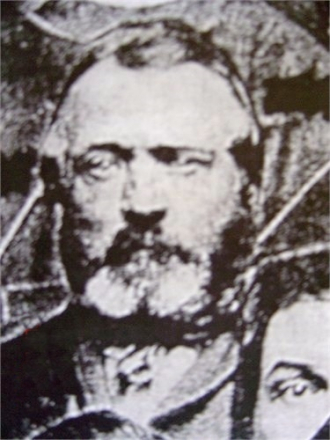
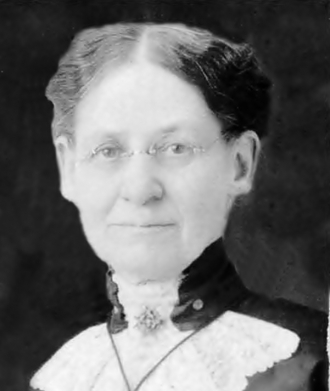
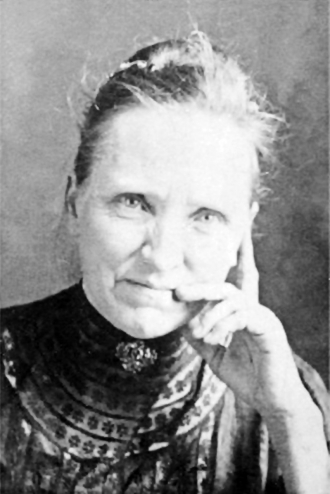
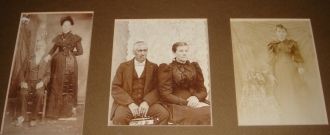

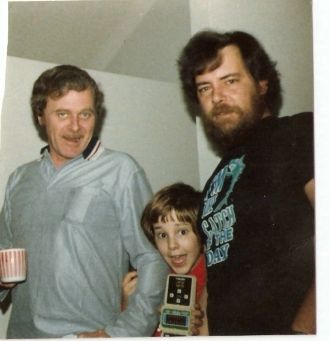

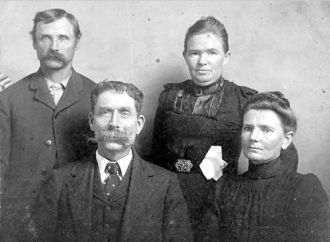

William Carr Blake was born in Northfield, Vermont, September 15, 1839. He followed his older brother’s, Levi Lowell Blake and Abraham Stearns Blake to Montana about 1866. Both Levi and Abraham Stearns were well-known Montana Pioneers.
Levi Lowell Blake came to Montana with the Governor Stevens R. R. Survey. By 1860 he was living at Fort Owen in Stevensville and taking supplies to John Mullan, who was building the Mullan Road from Fort Benton to Walla Walla, Washington. In 1870 Levi returned to the East to live, and became the Captain of several different Steamships which plied the Potomac River from Washington D. C. to MT. Vernon.
Abraham Stearns Blake came to Montana from the California gold fields in 1861. He remained in Montana until his death at his home in Victor, MT in 1907. He was a member of the House of Representatives at its first session, 1889-90 and a Delegate of the State Legislative Assembly in its second session, 1891-92.
William Carr Blake located in Deer Lodge in 1867 and was employed as a horticulturist at a local greenhouse. In 1872 a quote from the local newspaper credits him with being the most superior horticulturist in the territory.
NEW NORTHWEST DEER LODGE 1872
*********LOCAL NEWS**********
THE GREEN HOUSE – For some weeks past Mr. Blake has been putting in order Olin’s Green House, adjoining town, which attracted so much attention last year. He has already sown a great many seeds, and will have radishes, lettuce, etc., in the market in a few days. Everything grows as if by magic, the beds being heated by hot water pipes underneath them, and the steam furnishing moisture. Mr. Blake has no superior in the Territory as a Horticulturist, and is also a fine Botanist and converses fluently with the flowers in their different tongues, even though many of them speak by aid of the “dead languages.” He will have a great variety of flowers, from the largest gardens of the East; and tomatoes, --etc. etc…. for transplanting when the proper time arrives. Persons having house plants that were cut down by the cold, can leave them in the green-house and in a short time they will revive again. A number of such are there now, doing finely.
Another 1872 entry reads as follows:
NEW NORTHWEST DEER LODGE, MONT.
Recovering – Warden Gilchrist was removed to his room at the Prison several days ago, and is getting along finely. He will soon be around all right again.
Mr. W. C. Blake, who was stricken down with typhoid fever some ten days ago, is at the Scott House, improving rapidly. Disease attacked both these gentlemen with unusual severity, but through the skillful treatment and careful attention of their physician (Dr. Whitford) their friends will be rejoiced to know they will soon be as well as ever.
After seemingly having recovered from Typhoid Fever, William was again taken ill, and died May 10, 1872.
Following is his MEMORIAL RESOLUTION:
Died--
Blake – In Deer Lodge. Friday May 10, of Typhoid Fever. Wm. C. Blake, a native of Northfield, Vermont, aged 33 years.
MEMORIAL RESOLUTIONS
At a meeting of the citizens of Deer Lodge City, Montana, at the Court House. On the 13th day of May, 1872. For the purpose of paying proper respect to the memory of the late William C. Blake, deceased. Col. W.L. Irvine was called to the Chair, who stated the object of the meeting, and J. C. Robinson was chosen Secretary.
On motion, the Chair appointed Rev. W. H. Stoy, E. S. Stackpole and W. A. Clarke a Committee to draft Resolutions; who reported the following preamble and resolutions., which were unanimously adopted.
Inasmuch as it hath pleased Almighty God, in His wise Providence to remove from our midst the soul of our deceased friend and fellow citizen William C. Blake; Therefore be it.
Resolved. By us. The citizens of Deer Lodge City, of the Territory of Montana; That, while we bow in humble submission to the Divine Will, we do recognize in this afflictive dispensation the loss of a most worthy and valued man and citizen.
Resolved. That we have beheld in the life and character of Mr. Blake a degree of virtue, intelligence, uprightness and integrity of life worthy of all honor and emulation: And that we do here place on record our high sense of approbation of his many virtues and graces of character.
Resolved. That we express to the relatives and near friends of the deceased, who are bereaved by this affliction, our sincere sympathy and condolence.
Resolved. That copies of this preamble and resolutions be transmitted to the relations of the late William C. Blake, and that they be published in the New North West, and Weekly Independent of this city.
Respectfully submitted,
W. H. Stoy
E. S. Stackpole Com.
W. A. Clarke
On motion the meeting adjourned. W. L. Irvine, President.
J. C. Robinson, Sec’y.
By: Patricia Close
[contact link]